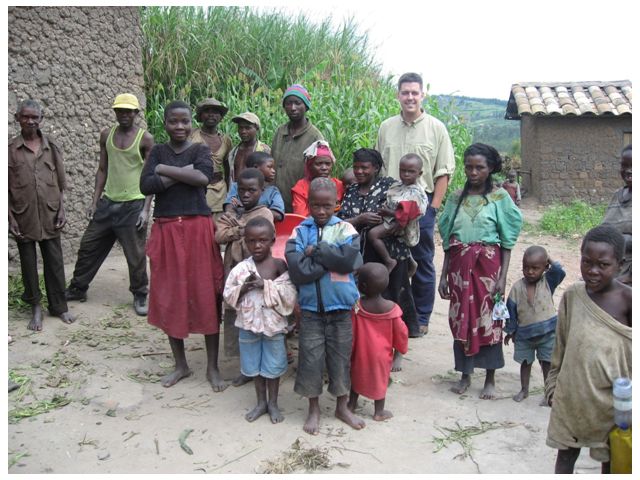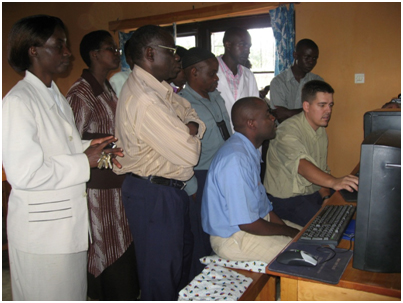A 'technology muzungu' in Rwanda

Ferdig (center, near back), poses with natives of this Twa village in rural Rwanda. He has been working with Rwandan schools to find inexpensive technologies to meet the needs of the east-central African nation.
One of the pleasures of working at UF’s College of Education is being able to apply high-end technologies to learning and teaching. For example, in 2002, we began delivering online courses and degrees to educators across Florida wanting to advance their education and careers without leaving their classrooms. We have received funding to evaluate virtual K-12 schools and the performance of students in 22 states last year. And, we explore innovative technologies such as virtual reality, educational gaming, social software and how they can be used to enhance teaching and learning.
My own virtual world "collided" with a much different reality this past summer when I traveled to Rwanda in east-central Africa to explore future educational relationships. Rwanda, with a population of about 9 million, gained national attention for the genocide in 1994 when close to a million people were slain within a few short months. However, post-civil war Rwanda has shown a remarkable ability to heal and rebuild. The country is also known for its mountain gorilla population, which now numbers only about 700 in the world. The College’s own Linda Jones, a professor in science education, has traveled to the region to partake in the study and conservation of the gorillas.

Ferdig (seated) toured several Rwandan schools to assess the ways the central African nation is already using techonology to teach—and to find affordable ways to bring 21st century technology to more Rwandan schools.
Rwanda’s educational system struggles with many of the same issues facing our own educational system — the need to train teachers, build literacy within schools and homes, reduce drop-out rates, and build a better economic structure in support of education. And, like in America, adapting technology to improve education is on the forefront of their working agenda. The good news is that Rwanda has formed a national Information and Communications Technology (ICT) strategy to link schools. The bad news is that there is a tremendous shortage of ICT skills in addition to a lack of accessible electricity outside of the main cities and towns.
My visit to Rwanda this past summer was funded through a travel grant from UF’s Center for African Studies. One goal of the trip was to work with a local Rwandan educator to evaluate the role of technology in Rwandan schools. At the same time, I wanted to build upon an existing relationship in the College’s international education program through our partners in the United States, Denmark, Spain, and England. The hope was to set up future trips for faculty and students at UF. One of the highlights of my trip was a visit to the aptly-named Green Hills Academy. The K-12 school was in the center of Kigali and was one of the most remarkable schools that I have ever visited in any country. School leaders and teachers believes that integration between content areas is a key to success. Their instructors meet frequently to ensure that completing an art project requires students to use math, science, literature and music. Students move from one class to another physically, but they are constantly reminded of the connection between academic content.
I also visited the ACEJ boarding and secondary school in Gitarama. Unlike Green Hills, ACEJ has little electricity and technology to support their pedagogic goals. No matter how strongly I believed in the potential of educational gaming or virtual reality, it would not necessarily help a school that did not have access to those tools. Faced with this dilemma, I decided to donate a collection of handhelds to the school. Handheld computers represent an ‘older’ technology, but they present an important opportunity for schools. Teachers can get on one Internet-based machine and freely download hundreds of pieces of software and content to a handheld. Once one handheld is equipped, students can easily beam the software to each other and then carry the equipment to various classes. They can also tote the handhelds from class to class and carry them home (recharging the batteries when they return the next day).
I spent most of my time at ACEJ working with the teachers, helping them understand how this technology might be implemented. At the school, I quickly became known as the "technology mzungu." (Mzungu literally means white person, or my favorite translation of "half-baked" in most languages of east, central, and south Africa.)
I returned from my trip invigorated by our potential relationships with Rwanda and other countries in Africa. We are currently seeking funding to take UF faculty, graduate students, and teacher education students to Rwanda for their practicum experiences so they can experience what Africa has to offer. I am also rejuvenated by the potential of technology to influence the teaching practice in schools, with or without electricity or other essentials of civilization-be it in a small Rwandan village or some rural outpost in our own nation or neighboring country.
— Rick Ferdig
Associate Professor, Education Technology




